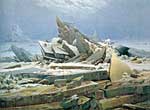


 |
 |
 |
 |
|||||||
 |
|||||||
| Home Again Studio Gallery, Museum Sensenhammer, Leverkusen In December 2001, after three years of a full renovation and a re-orientation of its purpose, the Alte Nationalgalerie (Old National Gallery) on the Museumsinsel in the heart of Berlin re-opened. It is a wonderful museum now, a celebration for the eyes in both its building and its collections. Each time I find myself in Berlin-Mitte I use the opportunity to stop by the museum, sometimes just for some moments, to enjoy this jewel box. I have especially been drawn to the exhibition room of Caspar David Friedrich in one of the upper floors. I was surprised by the fact that the great German Romantic (1774-1840) suddenly had such a deep impact on my perception of art history. After having lived abroad for several years, I found a new starting point in these German romantic paintings. There exists a certain analogy between the Romantic era and the time we are now living in. At the time of C.D. Friedrich, the German lands were in a state of stagnation, filled with longing, everyone aware that the ideals of the French Revolution had not been established at all in these regions. There was a widespread desire for reform and renewal. But instead the situation went nowhere. Such a hope for a fundamental change in society is not unique to the time of C.D. Friedrich. Friedrich's painting "Eismeer" ("The Sea of Ice," 1823-24, long in the Kunsthalle in Hamburg) has had an important effect on me: its depiction of the broken piles of ice on a frozen sea calls attention to the inability of change in the world of Friedrich's time. That is why I used it as a role model for the body of work you can see on this page. large painting on the right, oil on canvas, 80" x 108" small paintings, oil on canvas, 17" x 40" single paintings |
|||||||
 |
Caspar David Friedrich "The Sea of Ice," 1823-24 created in Dresden, Saxony oil on canvas, 38" x 50" Hamburger Kunsthalle |
||||||